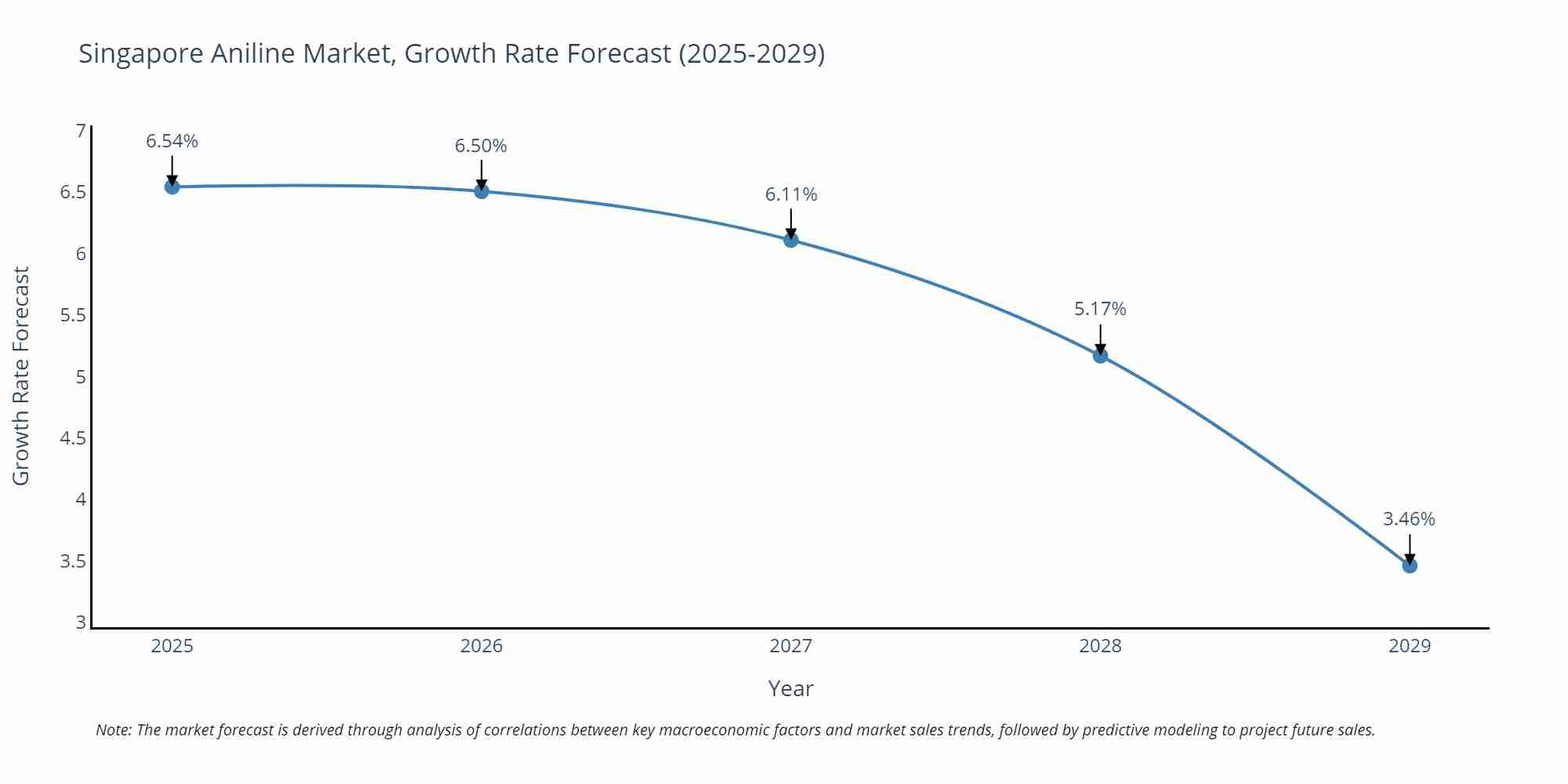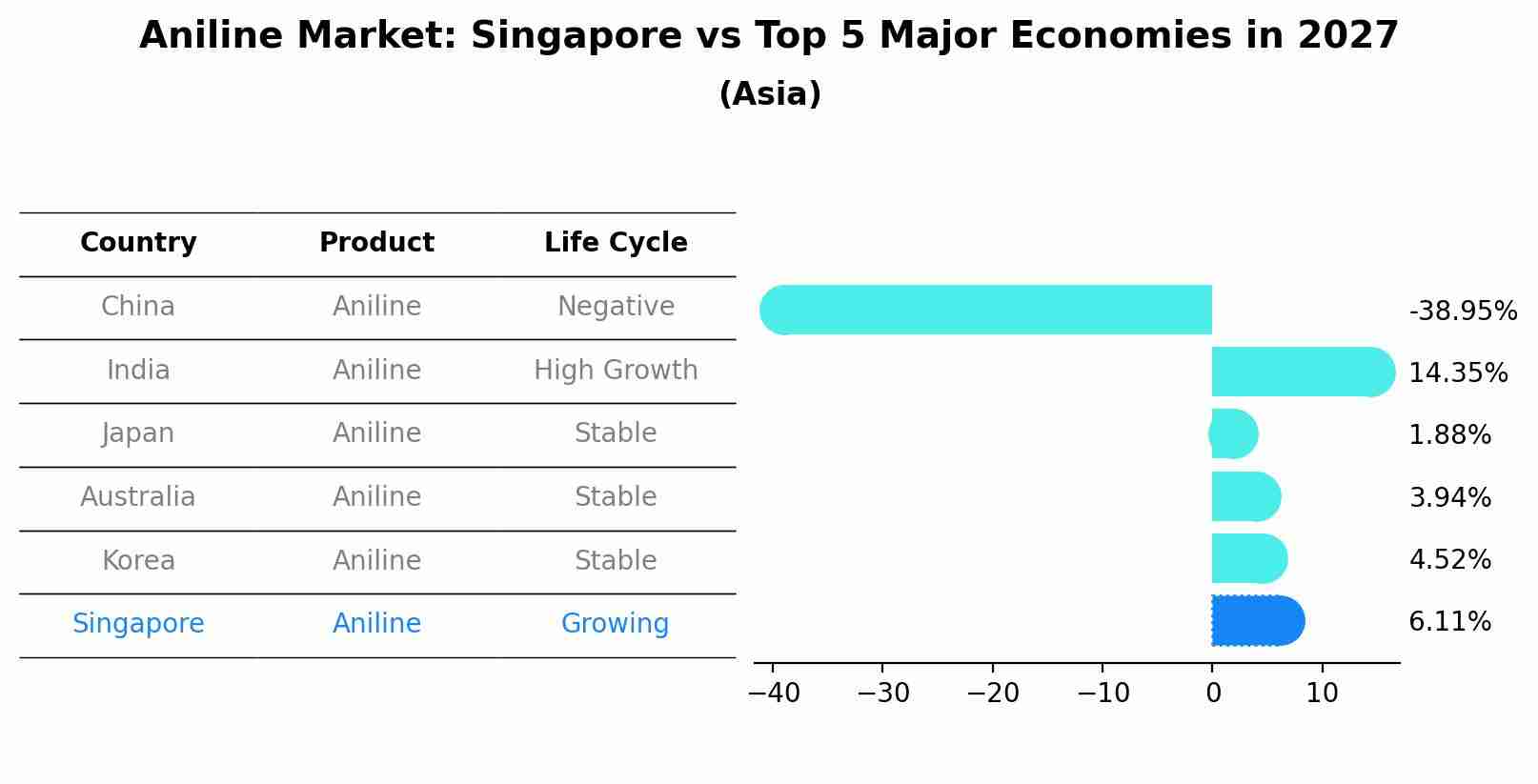Singapore Aniline Market (2025-2031) Outlook | Forecast, Industry, Companies, Growth, Size, Share, Trends, Analysis, Value & Revenue
| Product Code: ETC094966 | Publication Date: Jun 2021 | Updated Date: Apr 2025 | Product Type: Report | |
| Publisher: 6Wresearch | No. of Pages: 70 | No. of Figures: 35 | No. of Tables: 5 | |
Singapore Aniline Market Size Growth Rate
The Singapore Aniline Market could see a tapering of growth rates over 2025 to 2029. Beginning strongly at 6.54% in 2025, growth softens to 3.46% in 2029.

Aniline Market: Singapore vs Top 5 Major Economies in 2027 (Asia)
By 2027, the Aniline market in Singapore is anticipated to reach a growth rate of 6.11%, as part of an increasingly competitive Asia region, where China remains at the forefront, supported by India, Japan, Australia and South Korea, driving innovations and market adoption across sectors.

Singapore Aniline Market Synopsis
Aniline, a crucial chemical compound, serves as a building block for various industrial products, including dyes, pharmaceuticals, and rubber chemicals. The outlook for the aniline market in Singapore is shaped by its application in these sectors. The dye industry, in particular, relies heavily on aniline as a key raw material for producing a wide range of colorants used in textiles, plastics, and other materials. Aniline is also used in the synthesis of pharmaceuticals, where it serves as a precursor for numerous drugs. Furthermore, the rubber industry utilizes aniline in the production of accelerators and antioxidants. However, it`s important to note that aniline production and handling can pose environmental and health risks, which has led to regulatory scrutiny and a push towards more sustainable practices. Therefore, the outlook for the Singapore aniline market involves a balance between fulfilling industrial demands while adhering to strict safety and environmental standards. Additionally, innovation in aniline production methods and a focus on sustainability will play a crucial role in shaping the market`s future.
Drivers of the Market
The Singapore aniline market is set for substantial growth in the foreseeable future. Aniline is a key chemical used in the production of various industrial products, including dyes, rubber, and pharmaceuticals. One of the primary drivers of this market is the robust demand from the textile industry for aniline-based dyes and pigments. The construction and automotive sectors also contribute significantly to the market, using aniline in the production of polyurethane foams and coatings. Additionally, the healthcare industry relies on aniline derivatives for the synthesis of pharmaceuticals. The increasing industrialization and infrastructure development in Singapore are expected to bolster the aniline market, making it a promising sector in the coming years.
Challenges of the Market
The Singaporean aniline market faces a myriad of challenges as it strives to maintain stability and growth. Aniline, a key chemical compound used in various industries, is highly susceptible to fluctuations in global demand and raw material prices. The market`s outlook is influenced by factors such as the availability and cost of feedstock, which includes benzene and nitrobenzene. Environmental regulations and sustainability concerns have also placed pressure on aniline producers to adopt cleaner and greener production methods. Additionally, competition from other Asian countries with lower production costs poses a significant challenge to Singapore aniline market. Companies operating in this sector need to invest in research and development to innovate and stay competitive while adhering to stringent environmental standards.
COVID-19 Impact on the Market
The aniline market in Singapore faced challenges during the pandemic as it is used in the production of various industrial chemicals. Reduced industrial activity and disruptions in logistics impacted the market. As industries recover and resume operations, the demand for aniline is expected to pick up gradually.
Key Players in the Market
The Singapore aniline market is characterized by established players like Mitsui Chemicals and Huntsman International. These companies have been pivotal in producing high-quality aniline for applications in industries such as chemicals, pharmaceuticals, and rubber processing. Their commitment to safety, environmental sustainability, and product innovation has set them apart in the market. The consistent demand for aniline in various manufacturing processes underscores the significance of these key players in the industry.
Key Highlights of the Report:
- Singapore Aniline Market Outlook
- Market Size of Singapore Aniline Market, 2024
- Forecast of Singapore Aniline Market, 2031
- Historical Data and Forecast of Singapore Aniline Revenues & Volume for the Period 2021-2031
- Singapore Aniline Market Trend Evolution
- Singapore Aniline Market Drivers and Challenges
- Singapore Aniline Price Trends
- Singapore Aniline Porter's Five Forces
- Singapore Aniline Industry Life Cycle
- Historical Data and Forecast of Singapore Aniline Market Revenues & Volume By Product Type for the Period 2021-2031
- Historical Data and Forecast of Singapore Aniline Market Revenues & Volume By Synthetic Aniline for the Period 2021-2031
- Historical Data and Forecast of Singapore Aniline Market Revenues & Volume By Bio-Based Aniline for the Period 2021-2031
- Historical Data and Forecast of Singapore Aniline Market Revenues & Volume By Application for the Period 2021-2031
- Historical Data and Forecast of Singapore Aniline Market Revenues & Volume By Methylene Diphenyl Diisocyanate (MDI) for the Period 2021-2031
- Historical Data and Forecast of Singapore Aniline Market Revenues & Volume By Others for the Period 2021-2031
- Historical Data and Forecast of Singapore Aniline Market Revenues & Volume By Industry Vertical for the Period 2021-2031
- Historical Data and Forecast of Singapore Aniline Market Revenues & Volume By Building & Construction for the Period 2021-2031
- Historical Data and Forecast of Singapore Aniline Market Revenues & Volume By Rubber for the Period 2021-2031
- Historical Data and Forecast of Singapore Aniline Market Revenues & Volume By Consumer Goods for the Period 2021-2031
- Historical Data and Forecast of Singapore Aniline Market Revenues & Volume By Automotive for the Period 2021-2031
- Historical Data and Forecast of Singapore Aniline Market Revenues & Volume By Packaging for the Period 2021-2031
- Historical Data and Forecast of Singapore Aniline Market Revenues & Volume By Agriculture for the Period 2021-2031
- Historical Data and Forecast of Singapore Aniline Market Revenues & Volume By Others for the Period 2021-2031
- Singapore Aniline Import Export Trade Statistics
- Market Opportunity Assessment By Product Type
- Market Opportunity Assessment By Application
- Market Opportunity Assessment By Industry Vertical
- Singapore Aniline Top Companies Market Share
- Singapore Aniline Competitive Benchmarking By Technical and Operational Parameters
- Singapore Aniline Company Profiles
- Singapore Aniline Key Strategic Recommendations
Frequently Asked Questions About the Market Study (FAQs):
1 Executive Summary |
2 Introduction |
2.1 Key Highlights of the Report |
2.2 Report Description |
2.3 Market Scope & Segmentation |
2.4 Research Methodology |
2.5 Assumptions |
3 Singapore Aniline Market Overview |
3.1 Singapore Country Macro Economic Indicators |
3.2 Singapore Aniline Market Revenues & Volume, 2021 & 2031F |
3.3 Singapore Aniline Market - Industry Life Cycle |
3.4 Singapore Aniline Market - Porter's Five Forces |
3.5 Singapore Aniline Market Revenues & Volume Share, By Product Type, 2021 & 2031F |
3.6 Singapore Aniline Market Revenues & Volume Share, By Application, 2021 & 2031F |
3.7 Singapore Aniline Market Revenues & Volume Share, By Industry Vertical, 2021 & 2031F |
4 Singapore Aniline Market Dynamics |
4.1 Impact Analysis |
4.2 Market Drivers |
4.3 Market Restraints |
5 Singapore Aniline Market Trends |
6 Singapore Aniline Market, By Types |
6.1 Singapore Aniline Market, By Product Type |
6.1.1 Overview and Analysis |
6.1.2 Singapore Aniline Market Revenues & Volume, By Product Type, 2021-2031F |
6.1.3 Singapore Aniline Market Revenues & Volume, By Synthetic Aniline, 2021-2031F |
6.1.4 Singapore Aniline Market Revenues & Volume, By Bio-Based Aniline, 2021-2031F |
6.2 Singapore Aniline Market, By Application |
6.2.1 Overview and Analysis |
6.2.2 Singapore Aniline Market Revenues & Volume, By Methylene Diphenyl Diisocyanate (MDI), 2021-2031F |
6.2.3 Singapore Aniline Market Revenues & Volume, By Others, 2021-2031F |
6.3 Singapore Aniline Market, By Industry Vertical |
6.3.1 Overview and Analysis |
6.3.2 Singapore Aniline Market Revenues & Volume, By Building & Construction, 2021-2031F |
6.3.3 Singapore Aniline Market Revenues & Volume, By Rubber, 2021-2031F |
6.3.4 Singapore Aniline Market Revenues & Volume, By Consumer Goods, 2021-2031F |
6.3.5 Singapore Aniline Market Revenues & Volume, By Automotive, 2021-2031F |
6.3.6 Singapore Aniline Market Revenues & Volume, By Packaging, 2021-2031F |
6.3.7 Singapore Aniline Market Revenues & Volume, By Agriculture, 2021-2031F |
7 Singapore Aniline Market Import-Export Trade Statistics |
7.1 Singapore Aniline Market Export to Major Countries |
7.2 Singapore Aniline Market Imports from Major Countries |
8 Singapore Aniline Market Key Performance Indicators |
9 Singapore Aniline Market - Opportunity Assessment |
9.1 Singapore Aniline Market Opportunity Assessment, By Product Type, 2021 & 2031F |
9.2 Singapore Aniline Market Opportunity Assessment, By Application, 2021 & 2031F |
9.3 Singapore Aniline Market Opportunity Assessment, By Industry Vertical, 2021 & 2031F |
10 Singapore Aniline Market - Competitive Landscape |
10.1 Singapore Aniline Market Revenue Share, By Companies, 2024 |
10.2 Singapore Aniline Market Competitive Benchmarking, By Operating and Technical Parameters |
11 Company Profiles |
12 Recommendations |
13 Disclaimer |
- Single User License$ 1,995
- Department License$ 2,400
- Site License$ 3,120
- Global License$ 3,795
Search
Related Reports
- Australia IT Asset Disposal Market (2025-2031) | Strategy, Consumer Insights, Analysis, Investment Trends, Opportunities, Growth, Size, Share, Industry, Revenue, Segments, Value, Segmentation, Supply, Forecast, Restraints, Outlook, Competition, Drivers, Trends, Demand, Pricing Analysis, Competitive, Strategic Insights, Companies, Challenges
- UAE Building Thermal Insulation Market Outlook (2025-2031) | Revenue, Companies, Share, Trends, Growth, Size, Forecast, Industry, Analysis & Value
- Portugal Electronic Document Management Market (2025-2031) | Strategy, Consumer Insights, Analysis, Investment Trends, Opportunities, Growth, Size, Share, Industry, Revenue, Segments, Value, Segmentation, Supply, Forecast, Restraints, Outlook, Competition, Drivers, Trends, Demand, Pricing Analysis, Competitive, Strategic Insights, Companies, Challenges
- France Electronic Document Management Market (2025-2031) | Strategy, Consumer Insights, Analysis, Investment Trends, Opportunities, Growth, Size, Share, Industry, Revenue, Segments, Value, Segmentation, Supply, Forecast, Restraints, Outlook, Competition, Drivers, Trends, Demand, Pricing Analysis, Competitive, Strategic Insights, Companies, Challenges
- Portugal Occupational Health & Safety Services Market (2025-2031) | Strategy, Consumer Insights, Analysis, Investment Trends, Opportunities, Growth, Size, Share, Industry, Revenue, Segments, Value, Segmentation, Supply, Forecast, Restraints, Outlook, Competition, Drivers, Trends, Demand, Pricing Analysis, Competitive, Strategic Insights, Companies, Challenges
- Netherlands Occupational Health and Safety Services Market (2025-2031) | Strategy, Consumer Insights, Analysis, Investment Trends, Opportunities, Growth, Size, Share, Industry, Revenue, Segments, Value, Segmentation, Supply, Forecast, Restraints, Outlook, Competition, Drivers, Trends, Demand, Pricing Analysis, Competitive, Strategic Insights, Companies, Challenges
- Belgium and Luxembourg Facility Management Market (2025-2031) | Strategy, Consumer Insights, Analysis, Investment Trends, Opportunities, Growth, Size, Share, Industry, Revenue, Segments, Value, Segmentation, Supply, Forecast, Restraints, Outlook, Competition, Drivers, Trends, Demand, Pricing Analysis, Competitive, Strategic Insights, Companies, Challenges
- Russia Women Intimate Apparel Market (2025-2031) | Strategy, Consumer Insights, Analysis, Investment Trends, Opportunities, Growth, Size, Share, Industry, Revenue, Segments, Value, Segmentation, Supply, Forecast, Restraints, Outlook, Competition, Drivers, Trends, Demand, Pricing Analysis, Competitive, Strategic Insights, Companies, Challenges
- Africa Chocolate Market (2025-2031) | Size, Share, Trends, Growth, Revenue, Analysis, Forecast, industry & Outlook
- Global Hydroxychloroquine And Chloroquine Market (2025-2031) | Industry, Trends, Size, Outlook, Growth, Value, Companies, Revenue, Analysis, Share, Forecast
Industry Events and Analyst Meet
Our Clients
Whitepaper
- Middle East & Africa Commercial Security Market Click here to view more.
- Middle East & Africa Fire Safety Systems & Equipment Market Click here to view more.
- GCC Drone Market Click here to view more.
- Middle East Lighting Fixture Market Click here to view more.
- GCC Physical & Perimeter Security Market Click here to view more.
6WResearch In News
- Doha a strategic location for EV manufacturing hub: IPA Qatar
- Demand for luxury TVs surging in the GCC, says Samsung
- Empowering Growth: The Thriving Journey of Bangladesh’s Cable Industry
- Demand for luxury TVs surging in the GCC, says Samsung
- Video call with a traditional healer? Once unthinkable, it’s now common in South Africa
- Intelligent Buildings To Smooth GCC’s Path To Net Zero













